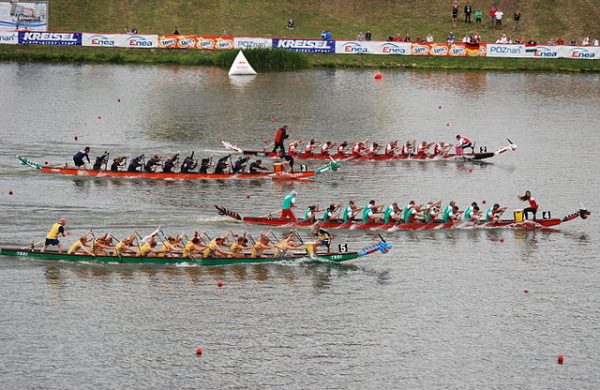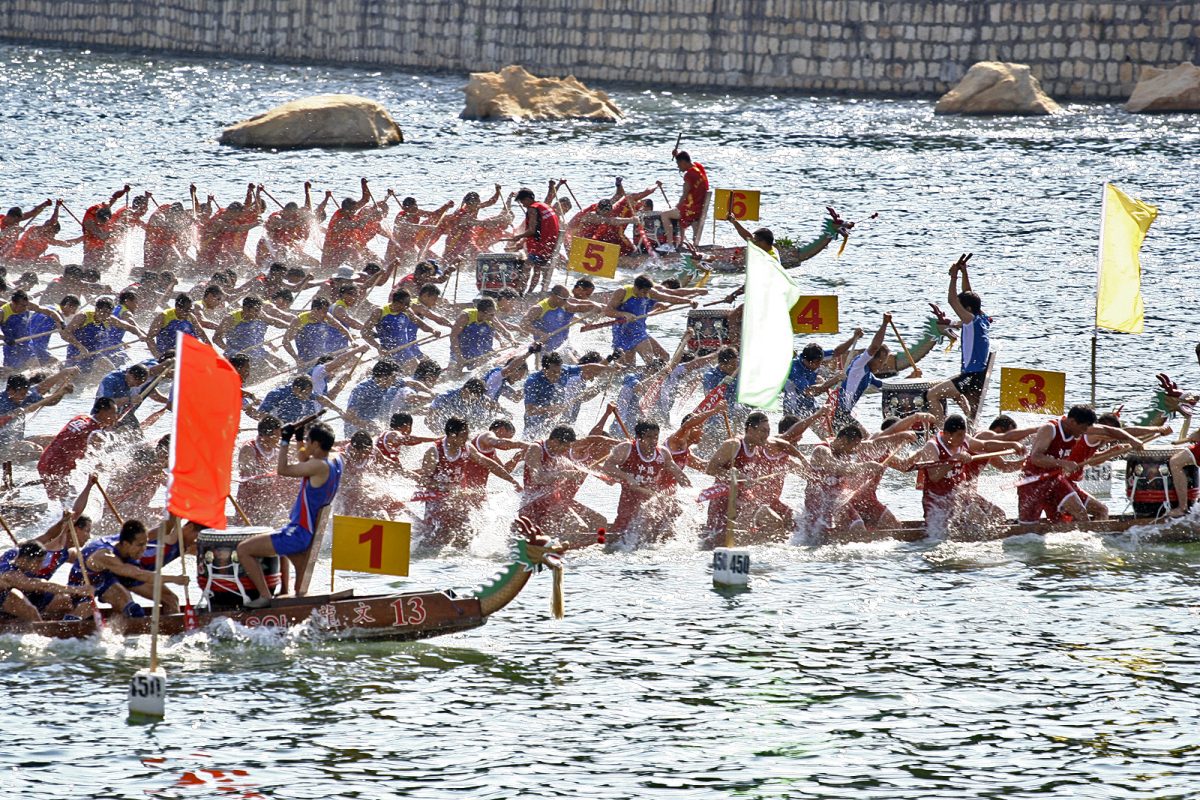Racing on the water to the rhythmic beat of hundreds of drums and the synchronized splashing of paddles, dragon boat racing is an electrifying fusion of ancient Chinese tradition and modern-day spectacle. Arising from the legendary tale of Qu Yuan and woven into the cultural tapestry of ancient China, the sport has transcended borders and time, captivating a diverse audience and becoming a modern cultural phenomenon.
The origins of the sport can be traced to roughly 300 B.C.E. and the tale of Qu Yuan. As legend has it, Qu Yuan was a revered poet and minister within the Chu Dynasty. He was known as a deeply devoted patriot and an advocate for the people of the Chinese empire. Unfortunately, Yuan’s incorruptible nature and the attention that his advocacy garnered created a rift between him and prominent court officials, who grew suspicious of his motives.
The king, operating with the counsel of the court officials, exiled Yuan. In his exile, Yuan, isolated from the community to which he had devoted his life, turned inward, focusing on his poetry. In the many verses he composed during his exile, he expressed the despair and helplessness that he felt, while also observing the political turmoil that the empire experienced. It was in his sorrowful state that he crafted perhaps his most renowned and influential work, ‘Li Sao,’ which roughly translates to ‘The Lament.’
Shortly after, Yuan’s beloved kingdom fell into the hands of rival nations following a period of civil unrest. Upon hearing the news, Yuan, an old and despondent man after his years in exile, drowned himself in the Miluo River. His death marked the arrival of the fifth day of the fifth lunar month.
As the news of Yuan’s tragic death swept the nation, people rushed to the river bed to wish his spirit farewell. They hurried into boats, beating drums loudly, and splashing water vigorously, in order to ward off fish and evil spirits alike from consuming his body. The legend also states that residents of surrounding villages flocked to the sight of Yuan’s tragic death and hurled the meager offerings they could afford, mostly zongzi (rice dumplings wrapped in bamboo leaves), into the river, as a tribute to his life of service.
Mourning Qu Yuan’s life continued for generations, as his melancholy poetry seemed to capture the sentiment of the Chinese people, appealing to communities across generations. His philosophical yet simplistic prose was uncommon among most Chinese literature during his time but expanded his influence after his death. Yuan became a martyr for the disenfranchised, and his death served as a reminder of the stability and honor that many believed had been lost during China’s political hardships.
As time went on, the practice of racing out into the river and tossing offerings into the water evolved into the contemporary Dragon Boat Festival, also known as Duanwu or the Double Fifth Festival, which is celebrated every year in mid-June.
Emerging from this tradition is the more modern adaptation of the sport. Its main feature is the distinctive long, vibrantly painted rowboat, ceremoniously adorned with a large dragon’s head. This well-known iconography of the dragon in Chinese culture is associated with power, honor, and good fortune. These ornately carved wooden heads that sit prominently at the bow often project a menacing expression, indicating the ferocity of the rowers.

(Photo Credit: Lucía Hernández / Unsplash)
During the late nineteenth century, as global travel became more accessible, travelers from Western Europe and America encountered the sport during their time in China. These tourists, along with the coinciding emigration of Chinese workers to the Americas and Europe, brought about a globalization of the sport. Because of the entertaining spectacle of the rhythmic drumming and brightly colored boats, coupled with the inherently non-violent nature of the sport, it was looked upon favorably by Westerners, who, in many other instances, took issue with various aspects of foreign culture.
As a result, many other nations adopted the tradition, adapting the rules and equipment to fit their circumstances. For many years, the sport was a leisurely pastime across the world, used primarily as a team-building exercise for various organizations. It has only been in recent years that national dragon boat federations that race have attempted to coordinate to standardize the sport.
The International Dragon Boat Federation (IDBF), founded in 1991, aims to do just that. It was conceived from the merging of many national federations, allowing the dragon boating community to expand its global reach. Founded in Hong Kong, the approximate birthplace of the tradition, the IDBF was the first organization to formalize international competition. In 1992, the federation established the first official rules and regulations, governing the sport on a global level and helping to standardize competition.
Shortly after the international regulations were ratified, in 1995, the IDBF held its first World Nations Championships in Yue Yang, China. In this inaugural event, the IDBF hosted 800 athletes from 14 different nations. It was an immediate success, and according to the IDBF, it ushered in the start of the ‘Modern Era’ of the sport.
“I think the IDBF has done a great job of giving our sport more exposure and giving more athletes an opportunity to compete,” said Scott Murray, president of Dragon Boat Canada. “In North America, it started in major East Coast cities like New York and Boston, but now we’ve seen it spread across the U.S. and Canada. It’s great to see that almost every major North American city has a dragon boat racing association.”
According to FMG Dragon Boat, the leading dragon boat festival planners in the U.S., attendance across all of their events has grown by 22% over the last three years. Even more exciting news for the sport, last year’s World Nations Championships, held in Pattaya, Thailand, saw record levels of attendance from spectators both in person and online.
“The recent growth of the sport makes me really excited about the future,” said Murray, “and I think the internet and stream is the key to continuing this growth, because it gives people the opportunity to see the passion and intensity of our sport up close.”
In New York, the growth of the sport is “noticeable,” said Terry Chin, the head coach for DCH, a competitive dragon boat racing team in Flushing, Queens. “What I’ve noticed is the huge increase in teens who want to join our youth program here which is really very promising,” said Chin. DCH, founded in 1993, originally with just a single competitive men’s team now trains all kinds of athletes, with ages ranging from twelve to sixty-five.
“That’s what I love about the sport.” said Murray. “It is open to all kinds of athletes. You can be 5’2″ or 6’5″, old or young, it doesn’t matter as long as you can pull your weight and are willing to work for it.”

Despite the recent success of the sport, one obstacle to the growth of Dragon Boating remains the issue of access. Dragon Boats must be large enough to accommodate twenty paddlers and a coxswain (the drummer). Additionally, they are typically custom-built so that they can be properly fitted with the dragon’s head and other traditional details that adorn the hull. Because of these requirements, Dragon Boats are difficult to build, making them relatively expensive and difficult to find.
“At DCH, we’re working on providing access,” said Chin, “but what I find to be the most challenging part of helping to start new teams is coordinating with twenty people. Dragon Boating is the ultimate team sport, and because it is hard to find time to practice, it really does require the commitment of every member.”
Even though the reliance on strong and committed team members makes it difficult to get started, it is also part of what makes Dragon Boating, “the ultimate team sport,” said Chin. Due to the sport’s focus on team unity, numerous corporate and public organizations have turned to Dragon Boating as a team-building exercise. Organizations in New York City, like branches of the NYPD and New York Presbyterian, have worked with DCH to organize Dragon Boating events for staff.
“I think it’s great that people are starting to understand what makes this sport great and we at DCH try to help spread Dragon Boating in any way that we can,” said Chin.
With the arrival of the 2024 season, the future of the sport certainly seems bright. The upcoming world championships set in Ravenna, Italy are on track to make waves, hosting a record number of athletes from eighty-eight different nations. “I am really excited for this season. The performances that I’ve seen, in terms of times, have been fantastic, and the sport is really starting to break into new markets. I think that 2024 has the potential to be a special year for us,” said Murray.
“That’s what I love about the sport,” said Scott Murray, president of Dragon Boat Canada. “It is open to all kinds of athletes. You can be 5’2″ or 6’5″, old or young, it doesn’t matter as long as you can pull your weight and are willing to work for it.”

